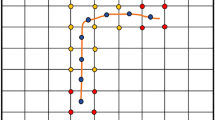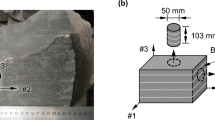Abstract
Hydraulic Fracturing (HF) is the prime technology for enhanced production from shale plays. Due to their laminations at different scales, shales exhibit transverse isotropic (TI) properties. In most cases the lamination planes are nearly horizontal with the symmetry axis being vertical, therefore, shales are referred to as TI vertical (TIV) rocks. This significantly influences the initiation and propagation of the induced fractures during fracturing operation. However, many studies on HF modeling in shales assume isotropic medium to simplify the problem. The anisotropic toughness is a distinct feature of layered formations such as shales, and its modelling is important to estimate the hydraulic fracturing initiation pressure, as well as the fractures geometry. In this work, to address the effect of TIV properties of the rock, we used the anisotropic toughness to develop the analytical models for fracture initiation pressure (FIP) based on data from the Bakken Shale, as a case study. In particular, we used ResFrac for calculations, which is a fully 3D HF and reservoir numerical simulator. Different scenarios of radial fracture for cases of single and multiple fractures were simulated for isotropic and anisotropic toughness conditions. The results showed that the hydraulic fracture initiation and propagation are strongly affected by the toughness anisotropy. An increase in the magnitude of anisotropy in toughness leads to an increase in the FIP. We also observed that the FIP varies with direction and consequently the fracture becomes more elongated in the direction of the minimum toughness and contained in the direction of the maximum toughness. In the case of multiple HFs, the combined effect of the anisotropy and the stress shadow was observed. This effect was stronger in the anisotropic case compared to the isotropic case. Hence, the isotropic approximation for TIV shale rocks can lead to inaccurate prediction of FIP and incorrect fracture morphology that can possibly affect the HF design.
Highlights
-
A novel analytical model was developed to investigate the fracture initiation pressure and morphology in a medium with anisotropic toughness.
-
Hydraulic fracture initiation and propagation showed a strong dependence on the transversely isotropic toughness.
-
The fracture initiation pressure varies with direction and consequently, the fracture becomes more elongated in the direction of the minimum toughness and contained in the direction of the maximum toughness.
-
The simultaneous propagation of multiple hydraulic fractures in anisotropic toughness was characterized by a stronger stress shadow effect compared to the case of isotropic toughness.
























Similar content being viewed by others
Data availability
Not applicable.
Change history
14 September 2023
A Correction to this paper has been published: https://doi.org/10.1007/s00603-023-03570-2
Abbreviations
- ρ :
-
Density
- E :
-
Young’s modulus
- UCS:
-
Uniaxial Compressive Strength
- T 0 :
-
Tensile Strength
- K IC-isotropic :
-
Isotropic fracture toughness
- K C,1 , K C,2 :
-
Fracture toughness in the plan of isotropy
- K C,3 :
-
Fracture toughness ⊥ to the plan of isotropy
- K I :
-
Mode I stress intensity factor
- ∅ :
-
Friction angle
- v :
-
Poisson’s ratio
- K :
-
Permeability
- σ H :
-
Maximum Horizontal Stress
- σ v :
-
Vertical Stress
- σ :
-
External confining stress
- P b :
-
Wellbore pressure
- P p :
-
Pore pressure
- P f :
-
Internal pressure within the fracture
- α :
-
Local initiation direction angle
- μ :
-
Fluid viscosity
- Q :
-
Flow rate
- a :
-
Borehole radius
- x :
-
Position variable along the fracture
- r :
-
Distance from the wellbore center
- L :
-
Fracture length
- f :
-
Configuration function depends on fracture geometry
- X, Y and Z :
-
Rectangular coordinates
References
Abbas S, Lecampion B, Prioul R (2013) Competition Between Transverse And Axial Hydraulic Fractures In Horizontal Wells. SPE Hydraul. Fract Technol Conf 13
Amadei B (1983) Rock anisotropy and the theory of stress measurements. Springer, Berlin Heidelberg
Benouadah N, Djabelkhir N, Song X et al (2021) Simulation of competition between transverse notches versus axial fractures in open hole completion hydraulic fracturing. Rock Mech Rock Eng. https://doi.org/10.1007/s00603-021-02378-2
Berry DS, Fairhurst C (1966) Influence of rock anisotropy and time-dependent deformation on the stress-relief and high-modulus inclusion techniques of. In: fifth pacific area national meeting of the society. ASTM International, 100 Barr Harbor Drive, PO Box C700, West Conshohocken, PA 19428–2959, pp 190–190–17
Berry DS (1968) The theory of stress determination by means of stress relief techniques in a transversely isotropic medium
Bessmertnykh A, Dontsov E (2018) Aspect ratio of hydraulic fracture in homogeneous transversely isotropic material
Britt LK, Schoeffler J (2009) The Geomechanics of a shale play: what makes a shale prospective
Bueckner HF (1970) Novel principle for the computation of stress intensity factors. Zeitschrift fuer Angew Math Mech 50:97–109
Chandler MR, Meredith PG, Brantut N, Crawford BR (2016) Fracture toughness anisotropy in shale. J Geophys Res Solid Earth 121:1706–1729. https://doi.org/10.1002/2015JB012756
Cipolla C, Litvak M, Prasad R, McClure M (2020) Case history of drainage mapping and effective fracture length in the Bakken. https://doi.org/10.2118/199716-MS. SPE-199716-MS
Daneshy A (2011) Hydraulic fracturing of horizontal wells: issues and insights. In: SPE hydraulic fracturing technology conference. The Woodlands, Texas, USA. https://doi.org/10.2118/140134-MS
Detournay E (2016) Mechanics of hydraulic fractures. Annu Rev Fluid Mech 48:311–339. https://doi.org/10.1146/annurev-fluid-010814-014736
Dontsov EV (2016) An approximate solution for a penny-shaped hydraulic fracture that accounts for fracture toughness, fluid viscosity and leak-off. R Soc Open Sci 3:160737. https://doi.org/10.1098/rsos.160737
Dontsov EV (2019) Scaling laws for hydraulic fractures driven by a power-law fluid in homogeneous anisotropic rocks. Int J Numer Anal Methods Geomech 43:519–529. https://doi.org/10.1002/nag.2874
Dontsov E (2022) Morphology of multiple constant height hydraulic fractures versus propagation regime. Int J Numer Anal Methods Geomech. https://doi.org/10.1002/nag.3335
Dontsov EV, Suarez-Rivera R (2020) Propagation of multiple hydraulic fractures in different regimes. Int J Rock Mech Min Sci 128:104270. https://doi.org/10.1016/j.ijrmms.2020.104270
Dontsov E (2021) Understanding fracture morphology-Resfrac. https://www.resfrac.com/blog/understanding-fracture-morphology. Accessed 25 Mar 2022
Heng S, Guo Y, Yang C et al (2015) Experimental and theoretical study of the anisotropic properties of shale. Int J Rock Mech Min Sci 74:58–68. https://doi.org/10.1016/j.ijrmms.2015.01.003
Heng S, Li X, Liu X, Chen Y (2020) Experimental study on the mechanical properties of bedding planes in shale. J Nat Gas Sci Eng 76:103161. https://doi.org/10.1016/j.jngse.2020.103161
Jin X, Shah SN, Roegiers J-C, Hou B (2013) Breakdown pressure determination-a fracture mechanics approach. In: SPE annual technical conference and exhibition. New Orleans, Louisiana, USA. https://doi.org/10.2118/166434-MS
Kabir P, Ulm F-J, Akono A-T (2017) Rate-independent fracture toughness of gray and black kerogen-rich shales. Acta Geotech 12:1207–1227. https://doi.org/10.1007/s11440-017-0562-0
Khan S, Ansari S, Han H, Khosravi N (2011) Importance of Shale Anisotropy in Estimating In-Situ Stresses and Wellbore Stability Analysis in Horn River Basin. Soc Pet Eng - Can Unconv Resour Conf 2011, CURC 2011. https://doi.org/10.2118/149433-MS
Ladd CC, Varallyay J (1965) The influence of stress system on the behavior of saturated clays during undrained shear
Li H, Zou YS, Liu S et al (2017) Prediction of fracture initiation pressure and fracture geometries in elastic isotropic and anisotropic formations. Rock Mech Rock Eng 50:705–717. https://doi.org/10.1007/s00603-016-1002-4
Martemyanov A, Lukin S, Ovcharenko Y et al (2017) Analytic modelling for wellbore stability analysis. Procedia Struct Integr 6:292–300. https://doi.org/10.1016/j.prostr.2017.11.045
McClure MW, Kang CA (2017) A three-dimensional reservoir, wellbore, and hydraulic fracturing simulator that is compositional and thermal, tracks proppant and water solute transport, includes non-darcy and non-newtonian flow, and handles fracture closure. In: Paper presented at the SPE reservoir simulation conference, montgomery, Texas, USA, Feb https://doi.org/10.2118/182593-MS
McClure M, Kang C, Medam S, Hewson C (2018) ResFrac Technical Writeup. arXiv Prepr arXiv180402092
McLamore R, Gray KE (1967) The mechanical behavior of anisotropic sedimentary rocks. J Eng Ind 89:62–73. https://doi.org/10.1115/1.3610013
Niandou H, Shao JF, Henry JP, Fourmaintraux D (1997) Laboratory investigation of the mechanical behaviour of Tournemire shale. Int J Rock Mech Min Sci 34:3–16. https://doi.org/10.1016/S1365-1609(97)80029-9
Nilson RH, Proffer WJ (1984) Engineering formulas for fractures emanating from cylindrical and spherical holes. J Appl Mech 51:929–933. https://doi.org/10.1115/1.3167748
Rice JR (1972) Some remarks on elastic crack-tip stress fields. Int J Solids Struct 8:751–758. https://doi.org/10.1016/0020-7683(72)90040-6
Savitski A, Lin M, Riahi A et al (2013) Explicit modeling of hydraulic fracture propagation in fractured shales. https://doi.org/10.2523/17073-MS
Schmidt DD, Smith SA, Sorensen JA, et al (2011) Evaluation of key factors affecting successful oil production in the bakken formation, North Dakota–Phase II. 15 North 23rd Street, Stop 9018 Grand Forks, ND 58202–9018
Tan P, Jin Y, Han K et al (2017) Analysis of hydraulic fracture initiation and vertical propagation behavior in laminated shale formation. Fuel 206:482–493. https://doi.org/10.1016/j.fuel.2017.05.033
Valès F, Nguyen Minh D, Gharbi H, Rejeb A (2004) Experimental study of the influence of the degree of saturation on physical and mechanical properties in Tournemire shale (France). Appl Clay Sci 26:197–207. https://doi.org/10.1016/j.clay.2003.12.032
Xu G, He C, Wang X (2020) Mechanical behavior of transversely isotropic rocks under uniaxial compression governed by micro-structure and micro-parameters. Bull Eng Geol Environ 79:1979–2004. https://doi.org/10.1007/s10064-019-01690-0
Zia H, Lecampion B, Zhang W (2018) Impact of the anisotropy of fracture toughness on the propagation of planar 3D hydraulic fracture. Int J Fract 211:103–123. https://doi.org/10.1007/s10704-018-0278-7
Acknowledgements
The authors would like to acknowledge the financial support of the North Dakota Industrial Commission (NDIC) for their financial support. Also, we would like to acknowledge other ResFrac team members for providing the support.
Author information
Authors and Affiliations
Corresponding author
Ethics declarations
Conflict of interest
There is no conflict of interest in this work.
Additional information
Publisher's Note
Springer Nature remains neutral with regard to jurisdictional claims in published maps and institutional affiliations.
Rights and permissions
About this article
Cite this article
Benouadah, N., Dontsov, E., Badrouchi, F. et al. Impact of Toughness Anisotropy on Fracture Initiation Pressure and Morphology in Shale Rocks. Rock Mech Rock Eng 56, 9149–9168 (2023). https://doi.org/10.1007/s00603-023-03502-0
Received:
Accepted:
Published:
Issue Date:
DOI: https://doi.org/10.1007/s00603-023-03502-0




